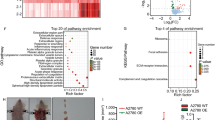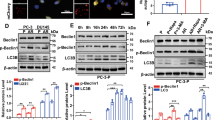Abstract
Breast cancer (BC) is the leading cause of cancer-related death in women in the world. Since tumor cells employ autophagy as a survival pathway, it has been proposed that autophagy inhibition could be beneficial for cancer treatment. There are several onging clinical trials where autophagy is being inhibited (using chloroquine, CQ or hydroxychloroquine, HCQ) along with chemotherapy with promising results. However, there is also in vitro evidence in which autophagy inhibition can induce epithelial to mesenchymal transition (EMT) in cancer cells, indicating that, at least in some cases, this strategy could be detrimental for cancer patients. In this study, we found that the genetic inhibition of autophagy primed cells for EMT by inducing a decrease in E-cadherin protein levels, while CQ treatment decreased E-cadherin levels, induced morphological changes related to EMT, increased EMT-related transcription factor (EMT-TF) expression and migration in estrogen receptor positive (ER +) BC cell lines. Importantly, CQ treatment increased intracellular reactive oxygen species (ROS) which induced the secretion of macrophage migration inhibitory factor (MIF), a pro-inflammatory cytokine related to malignancy. Both ROS production and MIF secretion were responsible for the mesenchymal morphology and increased migratory capacity induced by CQ. Our results indicate that CQ treatment increased malignancy by inducing ROS production, MIF secretion and EMT and suggest that autophagy inhibition in ER + BC patients might have detrimental effects. Our data indicates that a careful selection of patients should be performed in order to determine who will benefit the most from autophagy inhibition with available pharmacological agents for the treatment of breast cancer.






Similar content being viewed by others
References
Sung H, Ferlay J, Siegel RL, Laversanne M, Soerjomataram I, Jemal A, et al. Global Cancer Statistics 2020: GLOBOCAN Estimates of Incidence and Mortality Worldwide for 36 Cancers in 185 Countries. CA Cancer J Clin. 2021. https://doi.org/10.3322/caac.21660.
Polyak P. Heterogeneity in breast cancer. 2011. https://doi.org/10.1172/JCI60534.
Dai X, Li T, Bai Z, Yang Y, Liu X, Zhan J, et al. Breast cancer intrinsic subtype classification, clinical use and future trends. Am J Cancer Res. 2015.
Liu J-B, Feng C-Y, Deng M, Ge D-F, Liu D-C, Mi J-Q, et al. E-cadherin expression phenotypes associated with molecular subtypes in invasive non-lobular breast cancer: evidence from a retrospective study and meta-analysis. World J Surg Oncol. 2017. https://doi.org/10.1186/s12957-017-1210-8.
Lu S, Singh K, Mangray S, Tavares R, Noble L, Resnick MB, et al. Claudin expression in high-grade invasive ductal carcinoma of the breast: correlation with the molecular subtype. 2013. https://doi.org/10.1038/modpathol.2012.187.
Perou CM, Sørlie T, Eisen MB, Van De Rijn M, Jeffrey SS, Rees CA, et al. Molecular portraits of human breast tumours. Nature. 2000. https://doi.org/10.1038/35021093.
Fedele M, Cerchia L, Chiappetta G. The Epithelial-to-Mesenchymal Transition in Breast Cancer: Focus on Basal-Like Carcinomas. Cancers. 2017. https://doi.org/10.3390/cancers9100134.
Mulcahy Levy JM, Towers CG, Thorburn A. Targeting Autophagy in Cancer. Nat Rev Cancer. 2017. https://doi.org/10.1038/nrc.2017.53.
Amaravadi RK, Kimmelman AC, Debnath J. Targeting Autophagy in Cancer: Recent Advances and Future Directions. Cancer Discov. 2019. https://doi.org/10.1158/2159-8290.cd-19-0292.
Singh SS, Vats S, Chia AY, Tan TZ, Deng S, Ong MS, et al. Dual role of autophagy in hallmarks of cancer. Oncogene. 2018.
Rojas-Sanchez G, Cotzomi-Ortega I, Pazos-Salazar NG, Reyes-Leyva J, Maycotte P. Autophagy and Its Relationship to Epithelial to Mesenchymal Transition: When Autophagy Inhibition for Cancer Therapy Turns Counterproductive. Biology (Basel). 2019. https://doi.org/10.3390/biology8040071.
Maycotte P, Gearheart CM, Barnard R, Aryal S, Mulcahy Levy JM, Fosmire SP, et al. STAT3-mediated autophagy dependence identifies subtypes of breast cancer where autophagy inhibition can be efficacious. Cancer Res. 2014. https://doi.org/10.1158/0008-5472.
Maycotte P, Jones KL, Goodall ML, Thorburn J, Thorburn A. Autophagy Supports Breast Cancer Stem Cell Maintenance by Regulating IL6 Secretion. Mol Cancer Res. 2015. https://doi.org/10.1158/1541-7786.MCR-14-0487.
Cotzomi-Ortega I, Rosas-Cruz A, Ramírez-Ramírez D, Reyes-Leyva J, Rodriguez-Sosa M, Aguilar-Alonso P, et al. Autophagy Inhibition Induces the Secretion of Macrophage Migration Inhibitory Factor (MIF) with Autocrine and Paracrine Effects on the Promotion of Malignancy in Breast Cancer. Biology. 2020. https://doi.org/10.3390/biology9010020.
Richard V, Kindt N, Saussez S. Macrophage migration inhibitory factor involvement in breast cancer (Review). Int J Oncol. 2015. https://doi.org/10.3892/ijo.2015.3185.
Jankauskas SS, Wong DWL, Bucala R, Djudjaj S, Boor P. Evolving complexity of MIF signaling. Cell Signal. 2019. https://doi.org/10.1016/j.cellsig.2019.01.006.
Fabregat A, Jupe S, Matthews L, Sidiropoulos K, Gillespie M, Garapati P, et al. The Reactome Pathway Knowledgebase. Nucleic Acids Res. 2018. https://doi.org/10.1093/nar/gkx1132.
Cotzomi-Ortega I, Aguilar-Alonso P, Reyes-Leyva J, Maycotte P. Autophagy and Its Role in Protein Secretion: Implications for Cancer Therapy. Mediators Inflamm. 2018. https://doi.org/10.1155/2018/4231591.
Lee JP, Foote A, Fan H, Peral de Castro C, Lang T, Jones SA, et al. Loss of autophagy enhances MIF/macrophage migration inhibitory factor release by macrophages. Autophagy. 2016. https://doi.org/10.1080/15548627.2016.1164358.
Wang L, Ye X, Zhao T. The physiological roles of autophagy in the mammalian life cycle. Biol Rev Camb Philos Soc. 2019. https://doi.org/10.1111/brv.12464.
Roca-Agujetas V, de Dios C, Lestón L, Marí M, Morales A, Colell A. Recent Insights into the Mitochondrial Role in Autophagy and Its Regulation by Oxidative Stress. Oxid Med Cell Longev. 2019. https://doi.org/10.1155/2019/3809308.
Beese CJ, Brynjólfsdóttir SH, Frankel LB. Selective Autophagy of the Protein Homeostasis Machinery: Ribophagy, Proteaphagy and ER-Phagy. Front Cell Dev Biol. 2019. https://doi.org/10.3389/fcell.2019.00373.
Chude CI, Amaravadi RK. Targeting Autophagy in Cancer: Update on Clinical Trials and Novel Inhibitors. Int J Mol Sci. 2017. https://doi.org/10.3390/ijms18061279.
Redmann M, Benavides GA, Berryhill TF, Wani WY, Ouyang X, Johnson MS, et al. Inhibition of autophagy with bafilomycin and chloroquine decreases mitochondrial quality and bioenergetic function in primary neurons. Redox Biology. 2017. https://doi.org/10.1016/j.redox.2016.11.004.
Yang S, Qiang L, Sample A, Shah P, He Y-Y. NF-κB Signaling Activation Induced by Chloroquine Requires Autophagosome, p62 Protein, and c-Jun N-terminal Kinase (JNK) Signaling and Promotes Tumor Cell Resistance. J Biol Chem. 2017. https://doi.org/10.1074/jbc.m116.756536.
Qu X, Sheng J, Shen L, Su J, Xu Y, Xie Q, et al. Autophagy inhibitor chloroquine increases sensitivity to cisplatin in QBC939 cholangiocarcinoma cells by mitochondrial ROS. PLOS One. 2017. https://doi.org/10.1371/journal.pone.0173712.
Manic G, Obrist F, Kroemer G, Vitale I, Galluzzi L. Chloroquine and hydroxychloroquine for cancer therapy. Mol Cell Oncol. 2014. https://doi.org/10.4161/mco.29911.
Maycotte P, Aryal S, Cummings CT, Thorburn J, Morgan MJ, Thorburn A. Chloroquine sensitizes breast cancer cells to chemotherapy independent of autophagy. Autophagy. 2012. https://doi.org/10.4161/auto.8.2.18554.
Suarez-Carmona M, Lesage J, Cataldo D, Gilles C. EMT and inflammation: inseparable actors of cancer progression. Mol Oncol. 2017. https://doi.org/10.1002/1878-0261.12095.
Marcucci F, Ghezzi P, Rumio C. The role of autophagy in the cross-talk between epithelial-mesenchymal transitioned tumor cells and cancer stem-like cells. Mol Cancer. 2017. https://doi.org/10.1186/s12943-016-0573-8.
Lauzier A, Normandeau-Guimond J, Vaillancourt-Lavigueur V, Boivin V, Charbonneau M, Rivard N, et al. Colorectal cancer cells respond differentially to autophagy inhibition in vivo. Sci Rep. 2019. https://doi.org/10.1038/s41598-019-47659-7.
Mazouffre C, Geyl S, Perraud A, Blondy S, Jauberteau MO, Mathonnet M, et al. Dual inhibition of BDNF/TrkB and autophagy: a promising therapeutic approach for colorectal cancer. J Cell Mol Med. 2017. https://doi.org/10.1111/jcmm.13181.
Acloque H, Adams MS, Fishwick K, Bronner-Fraser M, Nieto MA. Epithelial-mesenchymal transitions: the importance of changing cell state in development and disease. J Clin Invest. 2009. https://doi.org/10.1172/jci38019.
Singh A, Settleman J. EMT, cancer stem cells and drug resistance: an emerging axis of evil in the war on cancer. Oncogene. 2010. https://doi.org/10.1038/onc.2010.215.
Guo W, Keckesova Z, Donaher JL, Shibue T, Tischler V, Reinhardt F, et al. Slug and Sox9 cooperatively determine the mammary stem cell state. Cell. 2012. https://doi.org/10.1016/j.cell.2012.02.008.
Lambert AW, Weinberg RA. Linking EMT programmes to normal and neoplastic epithelial stem cells. Nat Rev Cancer. 2021. https://doi.org/10.1038/s41568-021-00332-6.
Fischer KR, Durrans A, Lee S, Sheng J, Li F, Wong ST, et al. Epithelial-to-mesenchymal transition is not required for lung metastasis but contributes to chemoresistance. Nature. 2015. https://doi.org/10.1038/nature15748.
Zheng X, Carstens JL, Kim J, Scheible M, Kaye J, Sugimoto H, et al. Epithelial-to-mesenchymal transition is dispensable for metastasis but induces chemoresistance in pancreatic cancer. Nature. 2015. https://doi.org/10.1038/nature16064.
Jolly MK, Somarelli JA, Sheth M, Biddle A, Tripathi SC, Armstrong AJ, et al. Hybrid epithelial/mesenchymal phenotypes promote metastasis and therapy resistance across carcinomas. Pharmacol Ther. 2019. https://doi.org/10.1016/j.pharmthera.2018.09.007.
Xu D, Li J, Li RY, Lan T, Xiao C, Gong P. PD-L1 Expression Is Regulated By NF-κB During EMT Signaling In Gastric Carcinoma. Onco Targets Ther. 2019. https://doi.org/10.2147/ott.s224053.
Sulaiman A, Yao Z, Wang L. Re-evaluating the role of epithelial-mesenchymal-transition in cancer progression. J Biomed Res. 2018. https://doi.org/10.7555/jbr.31.20160124.
Jolly MK, Boareto M, Huang B, Jia D, Lu M, Ben-Jacob E, et al. Implications of the Hybrid Epithelial/Mesenchymal Phenotype in Metastasis. Front Oncol. 2015. https://doi.org/10.3389/fonc.2015.00155.
Gao J, Zhu Y, Nilsson M, Sundfeldt K. TGF-β isoforms induce EMT independent migration of ovarian cancer cells. Cancer Cell Int. 2014. https://doi.org/10.1186/s12935-014-0072-1.
Lundgren K, Nordenskjöld B, Landberg G. Hypoxia, Snail and incomplete epithelial–mesenchymal transition in breast cancer. Br J Cancer. 2009. https://doi.org/10.1038/sj.bjc.6605369.
Sundling KE, Lowe AC. Circulating Tumor Cells: Overview and Opportunities in Cytology. Adv Anat Pathol. 2019. https://doi.org/10.1097/pap.0000000000000217.
Berx G, Roy FV. The E-cadherin/catenin complex: an important gatekeeper in breast cancer tumorigenesis and malignant progression. Breast Cancer Research. 2001. https://doi.org/10.1186/bcr309.
Aiello NM, Maddipati R, Norgard RJ, Balli D, Li J, Yuan S, et al. EMT Subtype Influences Epithelial Plasticity and Mode of Cell Migration. Dev Cell. 2018. https://doi.org/10.1016/j.devcel.2018.05.027.
Varisli L, Cen O, Vlahopoulos S. Dissecting pharmacological effects of chloroquine in cancer treatment: interference with inflammatory signaling pathways. Immunology. 2020. https://doi.org/10.1111/imm.13160.
Klouda CB, Stone WL. Oxidative Stress, Proton Fluxes, and Chloroquine/Hydroxychloroquine Treatment for COVID-19. Antioxidants (Basel). 2020. https://doi.org/10.3390/antiox9090894.
Lee SY, Ju MK, Jeon HM, Lee YJ, Kim CH, Park HG, et al. Reactive oxygen species induce epithelial‑mesenchymal transition, glycolytic switch, and mitochondrial repression through the Dlx‑2/Snail signaling pathways in MCF‑7 cells. Mol Med Rep. 2019. https://doi.org/10.3892/mmr.2019.10466.
Niklaus NJ, Tokarchuk I, Zbinden M, Schläfli AM, Maycotte P, Tschan MP. The Multifaceted Functions of Autophagy in Breast Cancer Development and Treatment. Cells. 2021. https://doi.org/10.3390/cells10061447.
Dröse S, Altendorf K. Bafilomycins and concanamycins as inhibitors of V-ATPases and P-ATPases. J Exp Biol. 1997. https://doi.org/10.1242/jeb.200.1.1.
Mulcahy Levy JM, Thorburn A. Autophagy in cancer: moving from understanding mechanism to improving therapy responses in patients. Cell Death Differ. 2020. https://doi.org/10.1038/s41418-019-0474-7.
Sarmiento-Salinas FL, Delgado-Magallón A, Montes-Alvarado JB, Ramírez-Ramírez D, Flores-Alonso JC, Cortés-Hernández P, et al. Breast cancer subtypes present a differential production of reactive oxygen species (ROS) and susceptibility to antioxidant treatment. Front Oncol. 2019. https://doi.org/10.3389/fonc.2019.00480.
Zhao Z, Zhao J, Xue J, Zhao X, Liu P. Autophagy inhibition promotes epithelial-mesenchymal transition through ROS/HO-1 pathway in ovarian cancer cells. Am J Cancer Res. 2016.
Funding
This work was supported by the following projects: CONACYT CB 258123; FIS/IMSS/PRIO/15/049; CONACYT Infraestructura 2019 300379. GRS was supported by CONACYT (702827) and IMSS (97222355) scholarships.
Author information
Authors and Affiliations
Contributions
All authors contributed to the study conception, design and data analysis. Material preparation, data collection and analysis were performed by Guadalupe Rojas-Sanchez, Alin García-Miranda, José Benito Montes-Alvarado, Israel Cotzomi-Ortega, Fabiola Lili Sarmiento-Salinas, Eduardo Eleazar Jimenez-Ignacio, Dalia Ramírez-Ramírez, Rubí Esmeralda Romo-Rodríguez and Verónica Vallejo-Ruiz. The first draft of the manuscript was written by Guadalupe Rojas-Sanchez and all authors commented on previous versions of the manuscript. All authors read and approved the final manuscript.
Corresponding author
Ethics declarations
Conflict of Interest
The authors declare that the research was conducted in the absence of any commercial or financial relationships that could be construed as a potential conflict of interest.
Additional information
Publisher's Note
Springer Nature remains neutral with regard to jurisdictional claims in published maps and institutional affiliations.
Supplementary Information
Below is the link to the electronic supplementary material.
Rights and permissions
About this article
Cite this article
Rojas-Sanchez, G., García-Miranda, A., Montes-Alvarado, J.B. et al. Chloroquine Induces ROS-mediated Macrophage Migration Inhibitory Factor Secretion and Epithelial to Mesenchymal Transition in ER-positive Breast Cancer Cell Lines. J Mammary Gland Biol Neoplasia 26, 341–355 (2021). https://doi.org/10.1007/s10911-021-09503-5
Received:
Accepted:
Published:
Issue Date:
DOI: https://doi.org/10.1007/s10911-021-09503-5




